Physical Quantities and Measurement Chapter Notes | Physics Class 6 ICSE PDF Download
Introduction
In our daily lives, we need to measure many things to make the right choices. For example, we measure the weight of fruits to buy them, a tailor measures our height to stitch clothes, and a doctor measures our temperature when we are sick. Measurement helps us understand and compare things like length, weight, and temperature. This chapter will teach us what physical quantities are, how to measure them, and the correct ways to use tools like rulers and measuring tapes.
Physical Quantities
Physical quantities are things we can measure, like length, mass, area, time, temperature, and volume.
Physical quantities are divided into two types:
Fundamental Quantities
- Fundamental quantities do not depend on other quantities.
- Examples of fundamental quantities are length, mass, time, temperature, electric current, luminous intensity, and amount of substance.
- There are seven fundamental quantities in total.
Derived Quantities
- Derived quantities are made from fundamental quantities.
- Examples of derived quantities are area, volume, speed, force, and density.
- For example, area depends on length and breadth, and volume depends on length, breadth, and height.
Measurement of Physical Quantities
- When we measure an unknown physical quantity, we compare it with a known quantity.
- To measure any physical quantity, we need to know two things:
- The unit of measurement (like metre for length).
- The magnitude of measurement (a number that tells how many units are there, like 2 metres).
- For example, if a bucket weighs 2 kg, then kg is the unit of measurement, and 2 is the magnitude.
We can write a physical quantity as: P = N × U
Here, P is the physical quantity, N is the magnitude, and U is the unit. - For example, if N is 2, U is kg, then P is mass, which is 2 kg.
Units
- A unit is a fixed quantity used as a standard to measure physical quantities.
- For example, length is measured in metres, mass in kilograms, and volume in litres.
- Units are of two types: non-standard units and standard units.
Non-Standard Units
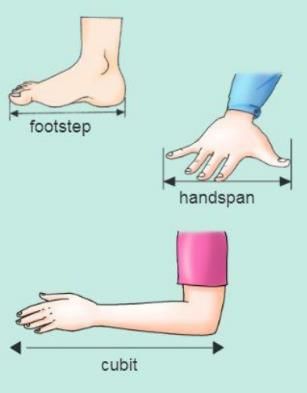
- Long ago, people used non-standard units to measure things.
- Examples of non-standard units are cubit, handspan, and footstep.
- These units were used to measure length, like the length from sunrise to sunset or the mass of seeds and pebbles.
- Non-standard units were not reliable because they changed from person to person.
- For example, the handspan of one person is different from another person’s handspan.
- Scientists needed a set of standard units to avoid confusion and measure accurately.
- Three systems of standard units were developed:
- CGS (centimetre-gram-second) system
- FPS (foot-pound-second) system
- MKS (metre-kilogram-second) system
SI Units
- Long ago, people used different units to measure physical quantities, which caused problems.
- Different units gave different results, and it was hard to compare them.
- Some basic physical quantities had complicated relations with other units.
- In 1960, the General Conference of Weights and Measures met in Paris and created the International System of Units (SI).
- The SI units are used all over the world for seven fundamental physical quantities.
The SI units are shown in the table below:
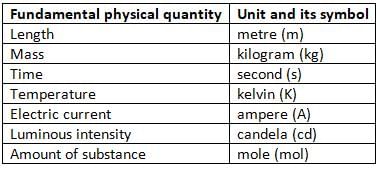
Rules for SI Units
We must follow some rules while using SI units:
- The name of a unit is always written in small letters, even if it is named after a scientist.
- For example, metre, watt, and joule are written in small letters.
- Symbols of units are written in small letters, except when named after scientists.
- For example, m for metre, kg for kilogram, but N for newton and W for watt.
- Symbols for derived units formed by multiplication are joined with a space or a centre dot.
- For example, the unit newton second is written as N s or N·s.
- Symbols for derived units formed by division are written with a slash (/) or a negative exponent.
- For example, the unit metre per second is written as m/s or m s⁻¹.
- Names of units can be written in plural form, like 5 metres.
- But symbols of units are always written in singular form, like 5 m, not 5 ms.
- Since symbols of units are not abbreviations, they do not end with full stops unless they are at the end of a sentence.
Multiples and Submultiples of Units of Measurement
- We use multiples and submultiples to measure very large or very small physical quantities.
- Multiples are used to make larger units, and submultiples are used to make smaller units.
- For example, we use kilometres to measure the distance between cities and millimetres to measure the size of a wire.
- Multiples use prefixes that are powers of 10, like kilo for thousand.
- Submultiples use prefixes that are fractions of 10, like milli for one-thousandth.
- We can express 100000 m as 100 km and 0.004 m as 4 mm.
The table below shows the multiples and submultiples of units: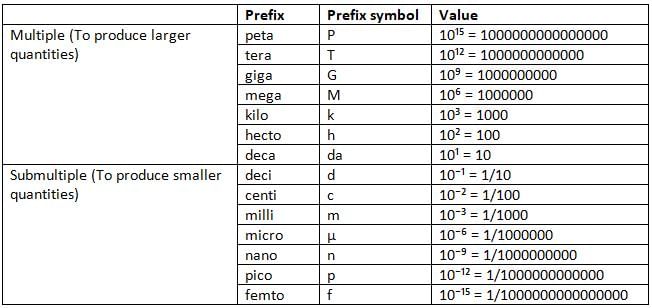
Measuring Length
- Length is one of the fundamental physical quantities.
- Length of an object is the distance between its two ends.
- The SI unit of length is metre (m).
- For example, if your teacher asks you to measure the length of a table, you will find the distance between the two ends of the table using a scale.
- Different objects have different lengths, so we use different units to measure them.
- We use small units for short lengths and large units for long lengths.
- We use different units for different lengths.
- For example, we measure the length of a book in centimetres and the distance between two cities in kilometres.
- The thickness of a wire is measured in millimetres, and the height of a person is measured in feet.
- The length between two planets is measured in astronomical units (A.U.).
The table below shows different units of length and how they are related: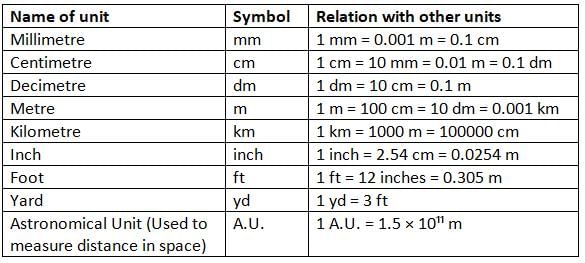
Instruments for Measuring Length
- We use different tools to measure length, like a ruler, metre rod, measuring tape, vernier callipers, and screw gauge.
- These tools are used to measure the thickness, diameter, length, and breadth of objects.
- Some devices for measuring length are shown below:
(a) Ruler
(b) Measuring tape
(c) Vernier callipers
(d) Screw gauge
Using a Metre Ruler/Rod to Measure Length
- We use a ruler to measure straight objects like books or pencils.
- Rulers are available in different lengths, like 30 cm or 15 cm, and can be made of plastic, wood, or metal.
- The smallest marking on a ruler is one millimetre (mm).
- A metre rod is 1 metre long and is divided into 100 divisions of 1 centimetre each.
- Each centimetre is further divided into 10 millimetres, so a metre rod can read up to 1 millimetre.
- To measure the length of an object using a ruler, follow these steps:
- Place the ruler along the length of the object, parallel to its markings.
- Make sure the zero mark of the ruler is at one end of the object.
- If the zero mark is not visible or broken, use another mark like 1 cm as the starting point.
- Note the reading at the other end of the object.
- If you started from a mark other than zero, subtract the starting mark from the final reading to get the length.
- For example, if the starting mark is 1 cm and the final reading is 6 cm, the length is 6 cm - 1 cm = 5 cm.
- When measuring, the position of your eye is very important.
- Your eye should be exactly above the mark to avoid errors.
- An error due to the wrong position of the eye is called parallax error.
- Always place the ruler correctly to get the right measurement:
(a) Correct method: Ruler is parallel to the object.
(b) Incorrect method: Ruler is not parallel to the object.
(c) Incorrect measurement: One end of the ruler is broken.
(d) Correct measurement: Start from a mark other than zero if the end is broken.

Using a Measuring Tape to Measure Length
- A measuring tape is used to measure long lengths of straight or curved objects.
- It is a flexible ruler made of cloth, plastic, or metal strip.
- It can be easily carried in a pocket and is used to measure curves or corners of objects.
- Measuring tapes come in different lengths like 1 m, 2 m, 5 m, 10 m, or 50 m.
- Surveyors use measuring tapes of lengths 50 m and 100 m to measure land.
- Tailors use measuring tapes to take measurements for stitching clothes.
Measuring Area
- Area is the space inside a two-dimensional shape, like the surface of an object.
- To measure the area, we need to know the length, breadth, or other dimensions of the object.
- The SI unit of area is square meter (m²), and the SI unit of length and breadth is meter (m).
- For a square cardboard with a side of 1 meter, the area is 1 m × 1 m = 1 m².
- For larger areas like a farm, house, or country, we use units like hectare and km².
- For smaller areas like a book, matchbox, or round plate, we use units like cm² and mm².
Relationship Between Various Units of Area:

Measuring Area of Regular Surfaces
Using Standard Formulae
- We can find the area of shapes like squares, rectangles, and triangles using specific formulas.
- For example, to find the area of a rectangular tray with length 8 cm and breadth 12 cm:
- Length = 8 cm
- Breadth = 12 cm
- Area of the tray = Length × Breadth = 8 cm × 12 cm = 96 cm²
Formulae for Area of Regular Surfaces: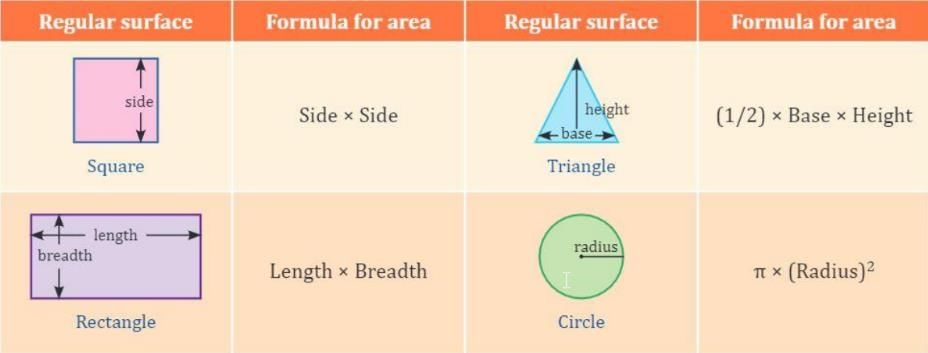
Using Graph Paper: We can also measure the area of a regular shape using graph paper.
Remember
- If the shape of an object covers ½ a square on graph paper, the area is taken as ½ square unit.
- If the shape of an object covers more than ½ a square on graph paper, the area is taken as 1 square unit.
- If the shape of an object covers less than ½ a square on graph paper, that square is left out.
Measuring Mass
- Mass is the amount of matter in an object.
- The more matter an object has, the heavier it is.
- We measure mass in units like kilogram (kg), milligram (mg), gram (g), quintal, and tonne.
- The SI unit of mass is kilogram (kg).
Relationship Between Various Units of Mass:

Instruments for Measuring Mass
We can measure mass using tools like a beam balance, physical balance, and electronic balance.
Measuring Mass with a Beam Balance
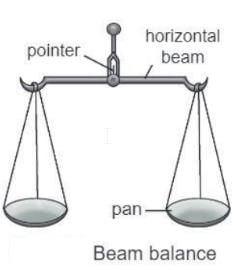
- A beam balance is a tool used to measure the mass of an object.
- Mass means how heavy something is.
- A beam balance has two pans that can move up and down.
- One pan holds the object you want to measure, and the other pan holds standard weights.
- The pans are connected by a beam, and the beam has a pointer in the middle.
- The pointer shows if the two pans are balanced or not.
- When the pans are at the same level, it means the mass of the object and the weights are equal.
- If the pans are not at the same level, the masses are not equal, and you need to adjust the weights.
- Standard weights are special weights used to measure mass accurately.
- These weights come in different sizes, like 1 g, 2 g, 5 g, 10 g, 20 g, 50 g, 100 g, 200 g, 500 g, 1 kg, 2 kg, 5 kg, and 10 kg.
- You add these weights to one pan until both pans are at the same level.
- When the pans are balanced, the total weight on the pan with standard weights tells you the mass of the object.
- For example, if you put an object on one pan and add 350 g of standard weights on the other pan to balance it, the mass of the object is 350 g.
Measuring Mass with Electronic Balance
- For scientific purposes, where measurements should be accurate, we need highly sensitive instruments.
- Nowadays, electronic weighing machines with digital displays are also used in laboratories and shops to measure mass.
- These machines can measure the mass of different objects, even small ones, very accurately.
- They can measure in units like grams and milligrams.
- Electronic machines give the mass instantly, so they are faster than a beam balance.
- For example, an object with a mass of 3.550 kg can be measured on an electronic machine.
- It is important to make sure the instruments we use for measuring are accurate.
- Before measuring, check that the device shows zero reading when there is nothing on it.
- For example, in a beam balance, the pans should be balanced when nothing is on them.
- In an electronic balance, the display should show 0 when nothing is placed on it.
Measuring Time
- Time is the gap between two events.
- We use units like seconds (s), minutes (min), hours (h), mean solar day, and years to measure time.
Relationship between Different Units of Time: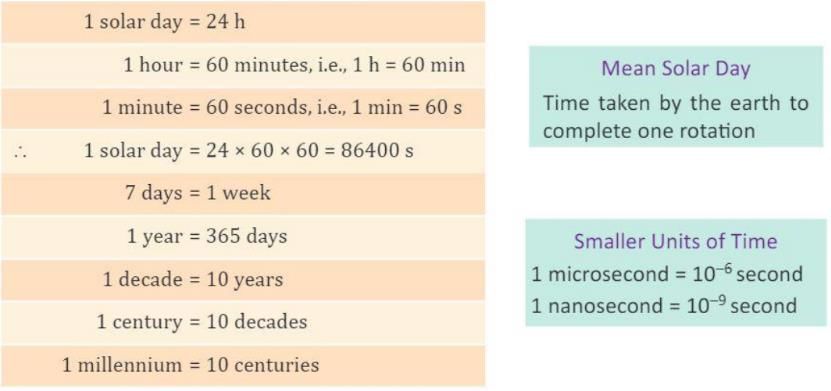
Did You Know?
Long ago, people used natural events that happen regularly to measure time. Some tools they used were sundials, candle clocks, and sand clocks.
Instruments for Measuring Time
There are many tools to measure time. Let's learn about a few of them:
Pendulum Clock
- A pendulum clock uses a swinging pendulum to keep time.
- The pendulum swings from one side to the other, and each swing takes the same amount of time.
- One swing of the pendulum equals 1 second.
- The clock has 12 big markings (numbers or bold marks) to show hours.
- These 12 big markings are divided into 5 smaller divisions, making 60 small divisions in total.
- The 60 small divisions show minutes.
- The clock has three needles: one for hours, one for minutes, and one for seconds.
- These needles move with the help of gear wheels inside the clock.
- When the pendulum swings from one side to the other, the second's needle moves one small division.
- After the second's needle completes 60 small divisions (one full round), the minute's needle moves to the next small division.
- When the minute's needle completes 60 small divisions (one full round), the hour's needle moves to the next big marking, which means 1 hour has passed.
Watch
- A watch also has markings like a clock to show time, but the way it works is different.
- In a watch, the hour, minute, and second's arms are set in motion by a wound-up spring.
- Modern watches are often electric and use a button cell instead of a wound-up spring.
- Watches that show time in numbers are called digital watches.
- Digital watches show time in the format hh:mm or hh:mm:ss.
Stopwatch and Stop Clock
- Stop clocks and stopwatches are used in labs and sports to measure short amounts of time accurately.
- They can measure time as small as 0.01 seconds.
- Electronic stopwatches and stop clocks are often used now.
- They have a display panel that shows time in the mm:ss format.
- Stopwatches are used in time-bound activities like sports events, debates, competitions, and more.
Clock System
There are two clock systems to measure time: the 12-hour clock system and the 24-hour clock system.
12-hour Clock System
- In the 12-hour clock system, a day (24 hours) is divided into two periods of 12 hours each.
- The time from midnight to noon is called a.m. (ante meridiem).
- The time from noon to midnight is called p.m. (post meridiem).
- For example, 6:15 a.m. means 6:15 in the morning, and 6:15 p.m. means 6:15 in the evening.
24-hour Clock System
- In the 24-hour clock system, a day is divided into 24 hours, numbered from 0 to 23.
- The time starts at 00:00 hours, which is midnight.
- Time from 00:00 to 12:00 hours is the morning to noon period (a.m.).
- Time from 12:00 to 24:00 hours is the noon to midnight period (p.m.).
- For example, 04:15 hours means 4:15 a.m., and 16:15 hours means 4:15 p.m.
- 16:15 hours is calculated as 16 - 12 = 4, so it is 4:15 p.m.
- The 24-hour system is commonly used in transportation services like railways and airways to avoid confusion in timings for passengers.
Measuring Temperature
- When we touch an object, we feel if it is hot or cold compared to our body.
- The degree of hotness or coldness of an object is called temperature.
- The SI unit of temperature is kelvin (K).
- Other units used to measure temperature are degree Celsius (°C), degree Fahrenheit (°F), and degree Rankine (°R).
- We use a device called a thermometer to measure temperature.
Did You Know?
Daniel Gabriel Fahrenheit (1686–1736) was a Polish-born Dutch-German physicist and maker of scientific instruments. He is best known for inventing the first modern thermometer, the mercury thermometer, and for developing the Fahrenheit temperature scale in 1714. This scale is used as a standard for scientific purposes worldwide.
Thermometer
- A thermometer is a device used to measure temperature.
- It is made of a thin, long glass tube called a capillary tube.
- The capillary tube has a bulb at one end that contains a liquid, either mercury or alcohol, which is used to measure temperature.
- Mercury is commonly used as the liquid in thermometers.
- When the thermometer touches a hot object, the mercury in the bulb gets hot, expands (gets bigger), and moves up the capillary tube.
- When the thermometer touches a cold object, the mercury cools down, contracts (gets smaller), and moves down the capillary tube.
- The capillary tube has markings that show the temperature in degree Celsius or Fahrenheit based on the mercury level.
Advantages of Using Mercury as a Thermometric Fluid
- Mercury can be easily seen through the glass because it is opaque (not see-through) and shiny.
- Mercury does not stick to the glass or wet it.
- Mercury can be used over a wide range of temperatures because of its low freezing point (–39°C) and high boiling point (357°C).
- Mercury is a good conductor of heat, so it quickly absorbs heat to show the temperature of the object.
Scales on a Thermometer
- Thermometers have markings based on two fixed points: the lower fixed point and the upper fixed point.
- These points are usually the freezing point and boiling point of water.
- The scales used on thermometers are Celsius, Fahrenheit, and Kelvin.
- In the Celsius scale, the lower fixed point is 0°C (the freezing point of water), and the upper fixed point is 100°C (the boiling point of water).
- The scale between 0°C and 100°C is divided into 100 equal parts, where each part is 1°C.
- In the Fahrenheit scale, the lower fixed point is 32°F, and the upper fixed point is 212°F.
- The scale between 32°F and 212°F is divided into 180 equal parts, where each part is 1°F.
- In the Kelvin scale, the freezing point of water is 273 K, and the boiling point is 373 K.
- The difference between the freezing and boiling points of water in each scale is 100 degrees in Celsius, 180 degrees in Fahrenheit, and 100 degrees in Kelvin.
Remember
- Temperature in degree Celsius can be converted into degree Fahrenheit using the formula: °F = (9/5 × °C) + 32.
- Temperature in degree Fahrenheit can be converted into degree Celsius using the formula: °C = 5/9 (°F – 32).
- Temperature in degree Celsius and Kelvin are related as: K = °C + 273.
- If the value on one temperature scale is known, the temperature on the other scale can be calculated.
Types of Thermometers
Thermometers are classified into three types based on their uses: clinical thermometer, laboratory thermometer, and maximum-minimum thermometer.
1. Clinical Thermometer
- A clinical thermometer is used to measure the body temperature of humans.
- It is also called a doctor’s thermometer.
- The scale on a clinical thermometer shows temperatures from 35°C to 42°C.
- The normal temperature of a healthy human body is 37°C.
- The temperature should not drop below 35°C or rise above 42°C unless there are serious health issues.
- A clinical thermometer has a slight bend or kink in the capillary tube just above the bulb.
- To measure the body temperature, the thermometer is placed in the mouth, below the tongue.
- The mercury in the bulb expands due to the body temperature and rises in the capillary tube.
- We take the thermometer out of the mouth after a minute (or two) and read the marking on the scale corresponding to the mercury level to know the body temperature.
- The kink in the capillary tube stops the mercury from falling back into the bulb when the thermometer is taken out of the mouth.
- The temperature outside our body is usually less than the body temperature, so the mercury contracts when the thermometer is removed.
- The mercury in the stem is brought back to the bulb by giving it a few soft jerks before using the thermometer again.
2. Laboratory Thermometer
- A laboratory thermometer is used to measure temperatures in the range of –10°C to 110°C.
- It is used in labs to measure temperatures with high precision.
- The construction of a laboratory thermometer is similar to a clinical thermometer, except it does not have a kink in the capillary tube.
- Some precautions to follow while measuring temperature with a laboratory thermometer:
- The thermometer should always be kept upright and not tilted.
- The bulb of the thermometer should be completely dipped in the substance whose temperature is to be measured.
- The bulb should not touch the base or the sides of the container.
Did You Know?
There is a type of thermometer called a maximum-minimum thermometer, also known as Six’s thermometer. It is used to measure the maximum and minimum temperatures of the day, especially in weather forecasting and horticulture (gardening). The maximum-minimum thermometer was invented by James Six in 1780.
Points To Remember
- Measurement is defined as the comparison of an unknown quantity with a known fixed quantity.
- Physical quantities are of two types: fundamental quantities and derived quantities.
- A unit is a fixed quantity that is used as a standard for measuring physical quantities.
- To deal with different magnitudes of physical quantities, we express the units in multiples and submultiples.
- Length is the distance between two extreme ends of an object. The SI unit of length is metre (m).
- We use measuring tools like a ruler, metre rod, Vernier callipers, and screw gauge to measure length.
- Area is the surface enclosed within the boundary of a two-dimensional figure.
- The mass of an object is the amount of matter contained in it. More the matter in a substance, the heavier it is.
- We use tools like beam balance, physical balance, and electronic balance to measure mass.
- Time is an essential part of our lives. Time may be defined as the interval between two events.
- The various units used for measuring time are second (s), hour (h), minute (min), mean solar day, and year.
- We use tools like pendulum clocks, watches, stopwatches, and stop clocks to measure time.
- Temperature is the measure of degree of hotness or coldness of a body. The SI unit of temperature is kelvin (K).
- A thermometer is used to measure temperature.
- Thermometers have markings based on two fixed points called the lower fixed point and upper fixed point.
- Based on their uses, thermometers are classified into three types: clinical thermometer, laboratory thermometer, and maximum-minimum thermometer.
Glossary
- Measurement: The comparison of an unknown quantity with a known fixed quantity.
- Physical quantity: A quantity that can be measured.
- Fundamental quantities: The quantities that are unique and do not depend upon any other quantity.
- Derived quantities: The quantities that are derived from fundamental quantities.
- Unit: A fixed quantity that is used as a standard for measuring physical quantities.
- Multiples of units: The factors used to create larger forms of the units.
- Submultiples of units: The factors which help in getting smaller forms of the units.
- Length: The distance between two extreme ends of an object.
- Parallax error: An error in measurement that arises due to the wrong positioning of the eye.
- Area: The space occupied by a two-dimensional figure on a plane.
- Mass: The amount of matter contained in an object.
- Time: The interval between two events.
- Temperature: The measure of degree of hotness or coldness.
- Thermometer: A device used to measure temperature.
- Clinical thermometer or doctor’s thermometer: A thermometer used to monitor the temperature of a human being.
- Laboratory thermometer: A thermometer that measures the temperature in the range of –10°C to 110°C.
|
8 videos|51 docs|6 tests
|
FAQs on Physical Quantities and Measurement Chapter Notes - Physics Class 6 ICSE
| 1. What are physical quantities and why are they important? |  |
| 2. What units are commonly used to measure mass? |  |
| 3. How is time measured and what units are used? |  |
| 4. What are the different methods for measuring temperature? |  |
| 5. How can practice questions help in understanding physical quantities and measurements? |  |
















